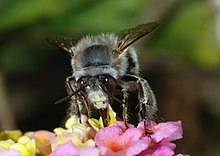Anthophora
Appearance
| Anthophora | |
|---|---|

| |
| Anthophora sp. | |
| Scientific classification | |
| Domain: | Eukaryota |
| Kingdom: | Animalia |
| Phylum: | Arthropoda |
| Class: | Insecta |
| Order: | Hymenoptera |
| Family: | Apidae |
| Tribe: | Anthophorini |
| Genus: | Anthophora Latreille, 1803 |
The bee genus Anthophora is one of the largest in the family Apidae, with over 450 species worldwide in 14 different subgenera. They are most abundant and diverse in the Holarctic and African biogeographic regions. All species are solitary, though many nest in large aggregations. Nearly all species make nests in the soil, either in banks or in flat ground; the larvae develop in cells with waterproof linings and do not spin cocoons. Males commonly have pale white or yellow facial markings, and/or peculiarly modified leg armature and hairs. Anthophora individuals can be distinguished from the very similar genus Amegilla by the possession of an arolium between the tarsal claws.
Species include:
- Anthophora abrupta[1]
- Anthophora bomboides[2]
- Anthophora bimaculata
- Anthophora californica[3]
- Anthophora curta[4]
- Anthophora dispar
- Anthophora edwardsii
- Anthophora fedorica
- Anthophora flexipes [5]
- Anthophora furcata
- Anthophora occidentalis[3]
- Anthophora plumipes
- Anthophora pueblo[6]
- Anthophora retusa
- Anthophora urbana[7]
See also
[edit]References
[edit]- C. D. Michener (2000) The Bees of the World, Johns Hopkins University Press.
- ^ Norden, Beth B. (1984). "Nesting Biology of Anthophora abrupta (Hymenoptera: Anthophoridae)". Journal of the Kansas Entomological Society. 57 (2): 243–262. ISSN 0022-8567. JSTOR 25084510.
- ^ Giblin, Robin M.; Kaya, Harru K. (15 March 1983). "Field Observations on the Association of Anthophora bomboides stanfordiana (Hymenoptera: Anthophoridae) with the Nematode Bursaphelenchus seani (Aphelenchida: Aphelenchoididae)1". Annals of the Entomological Society of America. 76 (2): 228–231. doi:10.1093/aesa/76.2.228.
- ^ a b Rubio, Amede; Wright, Karen; Longing, Scott (16 February 2022). "Bee and Flowering Plant Communities in a Riparian Corridor of the Lower Rio Grande River (Texas, USA)". Environmental Entomology. 51 (1): 229–239. doi:10.1093/ee/nvab108.
- ^ Orr, Michael C; Parker, Frank D; Woodard, S Hollis (12 December 2018). "A Tale of Two Cliff Dwellings: Parallels Between Humans and Native Bees". American Entomologist. 64 (4): 218–223. doi:10.1093/ae/tmy045.
- ^ Torchio, Philip F.; Youssef, Nabil N. (1968). "The Biology of Anthophora (Micranthophora) flexipes and Its Cleptoparasite, Zacosmia maculata, including a Description of the Immature Stages of the Parasite (Hymenoptera: Apoidea, Anthophoridae)". Journal of the Kansas Entomological Society. 41 (3): 289–302. ISSN 0022-8567. JSTOR 25083713.
- ^ Michael C. Orr; Terry Griswold; James P. Pitts; Frank D. Parker (12 September 2016). "A new bee species that excavates sandstone nests". Current Biology. 26 (17): R792 – R793. Bibcode:2016CBio...26.R792O. doi:10.1016/j.cub.2016.08.001. PMID 27623257.
- ^ Torchio, P. F.; Trostle, G. E. (1 May 1986). "Biological Notes on Anthophora urbana urbana and Its Parasite, Xeromelecta californica (Hymenoptera: Anthophoridae), including Descriptions of Late Embryogenesis and Hatching". Annals of the Entomological Society of America. 79 (3): 434–447. doi:10.1093/aesa/79.3.434.
External links
[edit]Wikimedia Commons has media related to Anthophora.
- Discover Life, Anthophora Identification Guide
- Discover Life, List of Species
- Discover Life, Worldwide Species Map
- Anthophora abrupta Say on the UF / IFAS Featured Creatures Web site
